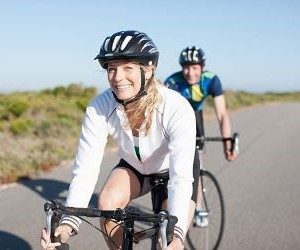Learn how to deal with punctures on long rides with prevention tips, repair techniques, and smart gear choices to keep rolling without stress.
HOW DO I AVOID OVERHEATING WHILE CYCLING IN SUMMER?
Cycling under the blazing summer sun can turn a joyful ride into a battle against heat. Overheating not only drains performance but also increases health risks like dehydration, cramps, and heatstroke. Knowing how to balance hydration, nutrition, gear selection, and route planning is crucial for surviving long summer rides. This article breaks down practical, science-backed strategies that every cyclist—from weekend warriors to competitive riders—can use to keep cool, maximize endurance, and avoid heat-induced setbacks.

Hydration and electrolyte balance
Cycling in summer challenges the body’s ability to regulate temperature, and fluid loss through sweat becomes the number one threat. Most cyclists underestimate how much water they need, leading to faster fatigue and even heatstroke. The key is to understand not just water intake but electrolyte replenishment—especially sodium, potassium, and magnesium—that keep muscles firing efficiently and prevent dangerous imbalances.
How much to drink before and during rides
A general rule is to start hydrating well before your ride. Consuming 500–700 ml of water 2–3 hours before cycling allows the body to store fluids. During the ride, cyclists should aim for 500–1000 ml per hour depending on intensity, body weight, and weather conditions. Sports drinks with electrolytes, or homemade solutions with salt and citrus, outperform plain water in long-distance rides, as they help replace what sweat removes.
Best electrolyte strategies for hot weather
Electrolytes aren’t optional—they are performance insurance. Adding tablets or powders into your bottles ensures you avoid hyponatremia (low blood sodium). Magnesium helps fight cramps, while potassium supports cardiac stability. Simple foods like bananas, salted nuts, and watermelon also work as natural sources during breaks.
Pre-hydrate before long rides with a mix of water and electrolytes.
Carry two bottles: one with water, one with electrolytes.
Refuel every 15–20 minutes with small sips instead of large gulps.
Monitor urine color as an easy hydration gauge.
The smartest riders treat hydration like pacing—it’s not optional. By structuring intake consistently, cyclists minimize overheating risks and unlock higher endurance levels, even in scorching conditions.
Clothing, gear, and cooling tactics
What you wear in summer cycling can make or break your ride. Cotton shirts trap sweat and turn into ovens, while technical fabrics wick moisture and enhance evaporation. Gear choices, helmet design, and even accessories like cooling towels influence how efficiently you can keep body temperature in check.
Choosing the right cycling apparel
Opt for lightweight jerseys with mesh panels for ventilation. Bib shorts with high breathability reduce heat build-up where airflow is usually low. Light-colored gear reflects sunlight, cutting down on heat absorption. Some pro riders even soak jerseys in cold water pre-ride, buying themselves an extra 20 minutes of thermal comfort.
Cooling techniques mid-ride
Strategic cooling hacks can save your ride from collapse. Pouring water over your head, wrists, or thighs rapidly lowers skin temperature. Ice socks—stockings filled with ice and tucked into your jersey—are a pro-level trick. Stopping briefly in shaded zones allows core temperature to stabilize without sacrificing too much pace.
Use ventilated helmets that promote airflow over the scalp.
Carry a cooling towel or bandana soaked in cold water.
Avoid dark-colored gear that absorbs excess heat.
Experiment with ice socks or frozen water bottles for endurance rides.
The golden rule is that every gram of sweat lost must be countered by smart gear choices. Professional teams invest heavily in heat management kits because cooling efficiency translates directly into sustained watts and fewer heat-induced DNFs.
Training adjustments and smart planning
Avoiding overheating is not just about hydration and clothing—it’s about when, where, and how you ride. Summer demands a shift in training rhythm, forcing cyclists to think more like strategists than grinders. Heat management starts before you even clip in.
Timing your rides for cooler hours
Early mornings and late evenings are natural allies. Road surfaces absorb less radiant heat, and humidity often drops slightly outside midday hours. A 6 a.m. ride may mean waking up earlier, but it drastically reduces overheating risks compared to noon rides under peak solar load.
Route selection and environment
Choosing shaded routes, tree-lined paths, or loops near water bodies gives the body natural cooling breaks. Long climbs under full sun should be swapped for rolling terrain or shorter repeats with shaded recovery sections. Smart planning also includes identifying gas stations or cafes along the route for hydration stops.
Acclimatization and pacing strategies
Acclimatization—gradually increasing exposure to heat—conditions the body to sweat more efficiently and improves plasma volume. This adaptation takes 7–14 days and can significantly reduce overheating risk. Coupled with pacing adjustments, such as starting slower in the first third of the ride, cyclists can stretch performance deeper into hot conditions without red-lining too soon.
Ride early or late to avoid peak heat hours.
Select shaded or water-adjacent routes.
Plan hydration stops into your route.
Acclimatize gradually over 1–2 weeks.
Overheating in summer cycling is not inevitable—it’s avoidable with smart training and route management. Riders who treat the environment as part of their training strategy unlock resilience and efficiency that their competition often overlooks.
YOU MAY ALSO BE INTERESTED






